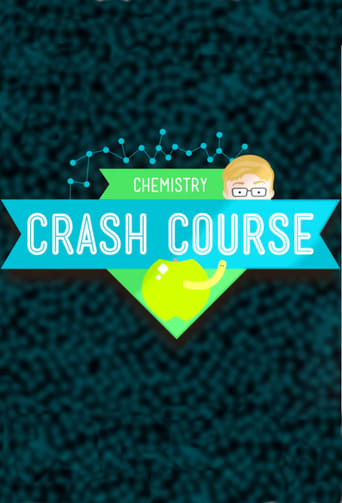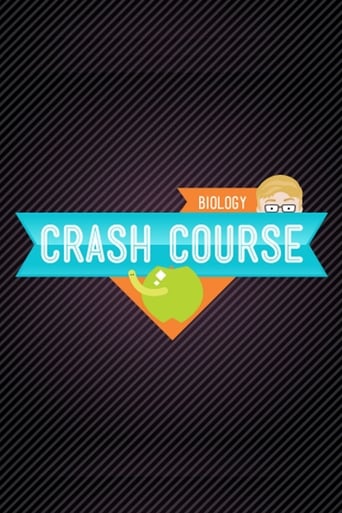Crash Course Chemistry (2013)
Crash Course Chemistry
2013
Hank does his best to convince us that chemistry is not torture, but is instead the amazing and beautiful science of stuff.
Seasons & Episode

A unit is the frequently arbitrary designation we have given to something to convey a definite magnitude of a physical quantity and every quantity can be expressed in terms of the seven base units that are contained in the international system of units. Hank thinks this is a thrilling subject, and while you may not agree, it is a subject that is very important if you want to be a scientist and communicate with accuracy and precision with other scientists.

Today's Crash Course Chemistry takes a historical perspective on the creation of the science, which didn't really exist until a super-smart, super-wealthy Frenchman put the puzzle pieces together - Hank tells the story of how we went from alchemists to chemists, who understood the law of conservation of mass as proposed by a decapitated aristocrat, and explains how we came to have a greater understanding of how chemical compounds work and eventually a complete understanding of what atoms and molecules are.

Hank gives us a tour of the most important table ever, including the life story of the obsessive man who championed it, Dmitri Mendeleev. The periodic table of elements is a concise, information-dense catalog of all of the different sorts of atoms in the universe, and it has a wealth of information to tell us if we can learn to read it.

Hank brings us the story of the electron and describes how reality is a kind of music, discussing electron shells and orbitals, electron configurations, ionization and electron affinities, and how all these things can be understood via the periodic table.

Chemists need stoichiometry to make the scale of chemistry more understandable - Hank is here to explain why, and to teach us how to use it.

Last week, Hank talked about how stuff mixes together in solutions. Today, and for the next few weeks, he will talk about the actual reactions happening in those solutions - atoms reorganizing themselves to create whole new substances in the processes that make our world the one we know and love. This week, we focus on acids and bases and their proton-exchanging ways.

A lot of ionic compounds dissolve in water, dissociating into individual ions. But when two ions find each other that form an insoluble compound, they suddenly fall out of solution in what's called a precipitation reaction. In this episode of Crash Course Chemistry, we learn about precipitation, precipitates, anions, cations, and how to describe and discuss ionic reactions.

All the magic that we know is in the transfer of electrons. Reduction (the loss of electrons) and oxidation (gaining electrons) combine to form Redox Chemistry, which contains the majority of chemical reactions. As electrons jump from atom to atom, they carry energy with them, and that transfer of energy is what makes all life on earth possible.

Learning to talk about chemistry can be like learning a foreign language, but Hank is here to help with some straightforward and simple rules to help you learn to speak Chemistrian like a native.

This week we continue to spend quality time with gases, more deeply investigating some principles regarding pressure - including John Dalton's Law of Partial Pressures, vapor pressure - and demonstrating the method for collecting gas over water.

We have learned over the past few weeks that gases have real-life constraints on how they move here in the non-ideal world. As with most things in chemistry (and also in life) how a gas moves is more complex than it at first appears. In this episode, Hank describes what it means when we talk about the velocity of a gas - to understand gas velocity, we have to know what factors effect it, and how. Hank also teaches you about effusion, diffusion and concentration gradients, before showing off a cool experiment that physically demonstrates the things you have just learned. Sound exciting enough for you? Let's get started.

Grumpy Professor Hank admits to being wrong about how everything is chemicals. But he now wants you to listen as he blows your mind with a new sweeping statement: everything (yes, really everything this time) is energy. What?! This week, Hank takes us on a quick tour of how thermodynamics is applied in chemistry using his toy trebuchet as an example, because he is a proud nerd.

Today's episode dives into the HOW of enthalpy. How we calculate it, and how we determine it experimentally...even if our determinations here at Crash Course Chemistry are somewhat shoddy.

Models are great, except they're also usually inaccurate. In this episode of Crash Course Chemistry, Hank discusses why we need models in the world and how we can learn from them... even when they're almost completely wrong.

In this episode of Crash Course Chemistry, Hank discusses what Molecules actually look like and why, some quantum-mechanical three dimensional wave functions are explored, he touches on hybridization, and delves into sigma and pi bonds.

In this episode of Crash Course Chemistry, Hank gives you the low down on things like London Dispersion Forces, Hydrogen Bonds, Cohesion, Adhesion, Viscosity, Capillary Action, Surface Tension, and why liquids are just...

This week, Hank elaborates on why Fugu can kill you by illustrating the ideas of solutions and discussing molarity, molality, and mass percent. Also, why polar solvents dissolve polar solutes, and nonpolar solvents dissolve nonpolar solutes. All that plus Henry's Law and why Coke = Burps.

In this episode of Crash Course Chemistry, Hank goes over the ideas of keeping your life balance... well, your chemical life. Equilibrium is all about balance and today Hank discusses Chemical Equilibrium, Concentration, Temperature, and Pressure. Also, he'll chat about Le Chatalier's Principle and Fritz Haber.

In which Hank shows you that, while it may seem like the Universe is messing with us, equilibrium isn't a cosmic trick. Here, he shows you how to calculate equilibrium constant & conditions of reactions and use RICE tables all with some very easy, not-so-scary math.

In this episode, Hank goes over Reversible Reactions, the water dissociation constant, what pH and pOH actually mean, Acids, Bases, and Neutral Substances as well as the not-so-terrifying Logarithms, strong acids, weak acids, and how to calculate pH and pOH.

In this episode, Hank talks about how nutty our world is via Buffers! He defines buffers and their compositions, talks about carbonate buffering systems in nature, acid rain, pH of buffers, and titration. Plus, a really cool experiment using indicators to showcase just how awesome buffers are.

Have you ever been to a Demolition Derby? Then you have an idea of how molecular collisions happen. In this episode, Hank talks about collisions between molecules and atoms, activation energy, writing rate laws, equilibrium expressions, reactions mechanics, and rate-determining steps.

In which Hank blows our minds with the different kinds of Solids out there and talks about why they're all different and have different properties. Today, you'll learn about amorphous and crystalline solids, types of crystalline solids, types of crystalline atomic solids, properties of each type of solid, and that the properties depend on the bond types.

Hank talks about Network solids and Carbon and how you can actually create a Diamond from plain old Carbon... well, YOU probably can't unless you own a bunch of elephants. It's a long story. BUT, within you will learn about Solid Networks, Diamond and Graphite Network Structures, as well as Sheet and 3D Networks. It's not making diamonds from scratch, but it's still pretty cool!

In this episode, we talk about Silicon Valley's namesake and how network solids are at the heart of it all. Hank also discusses Solid-State Semiconductors, N-Type and P-Type Semiconductors, Diodes, Transistors, Computer Chips, and Binary Code. All from the same thing that makes up sand!

Hank discusses electrochemical reactions, half reactions, how batteries work, galvanic cells, voltage, standard reduction potential, cell potential, electrolysis, and electro plating and the things that go into making it possible for you to watch this episode of Crash Course Chemistry!

How did we get here? Well, in terms of Atomic Chemistry, Hank takes us on a tour of the folks that were part of the long chain of other folks who helped us get to these deeper understandings of the world. From Leucippus to Heisenberg to you - yes, YOU - the story of Atomic Chemistry is all wibbly-wobbly... and amazing.

Hank welcomes you to the new age, to the new age, welcome to the new age. Here he'll talk about transmutation among elements, isotopes, calculating half-life, radioactive decay, and spontaneous fission.

Continuing our look at Nuclear Chemistry, Hank takes this episode to talk about Fusion and Fission. What they mean, how they work, their positives, negatives, and dangers. Plus, E=mc2, Mass Defect, and Applications of Fission and Fusion in the real world!

Hank introduces us to the world of Organic Chemistry and, more specifically, the power of hydrocarbon. He talks about the classifications of organic compounds, the structures & properties of alkanes, isomers, and naming an alkane all by observing its structure.

Today Hank talks about the deliciousness of alkenes & alkynes, their structures, and how to remember which is which by simply knowing the alphabet. Also, he breaks down hydrogenation, halogenation, polymerization, and triglycerides all while helping us figure out the meaning of different names for fats.

What's that smell? Smell's like Organic Chemistry! This week Hank talks about Aromatics and Cyclic Compounds and naming their substituents, resonance as well as common reactions & uses.

Functional groups? Functional groups within functional groups? Hank takes today's Crash Course video to discuss some confusing ideas about Hydrocarbon Derivatives, but then makes it all make more sense.

Did you know that Polymers save the lives of Elephants? Well, now you do! The world of Polymers is so amazingly integrated into our daily lives that we sometimes forget how amazing they are. Here, Hank talks about how they were developed an the different types of Polymers that are common in the world today, including some that may surprise you.

In this final episode of Crash Course Chemistry, Hank takes us on a tour of the The Global Carbon Cycle and how it all works. From Carbon Fixation to Redox Reactions, it's all contained within!
Hank does his best to convince us that chemistry is not torture, but is instead the amazing and beautiful science of stuff.
Watch Trailer
Free Trial Channels


























